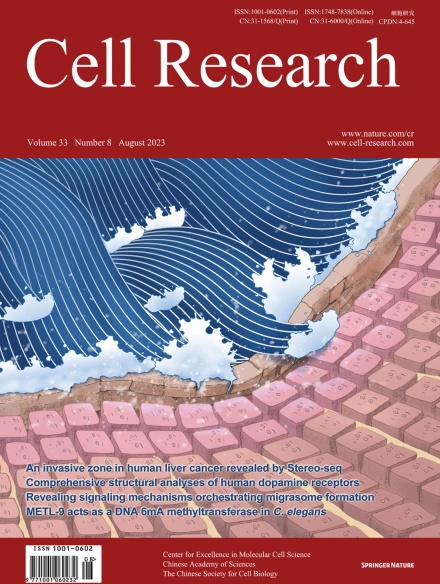
Advanced Search
Submit Manuscript
Advanced Search
Submit Manuscript
Volume 33, No 8, Aug 2023
ISSN: 1001-0602
EISSN: 1748-7838 2018
impact factor 17.848*
(Clarivate Analytics, 2019)
Volume 33 Issue 8, August 2023: 585-603 |
An invasive zone in human liver cancer identified by Stereo-seq promotes hepatocyte–tumor cell crosstalk, local immunosuppression and tumor progression
Liang Wu1,2,3,† , Jiayan Yan1,4,† , Yinqi Bai1,3,5,† , Feiyu Chen1,4,† , Xuanxuan Zou2,3,6,† , Jiangshan Xu3,6,† , Ao Huang1,4,† , Liangzhen Hou3,6 , Yu Zhong3 , Zehua Jing3,6 , 6, Qichao Yu3,6 , Xiaorui Zhou3,6 , Zhifeng Jiang4 , Chunqing Wang3,6 , Mengnan Cheng3,6 , Yuan Ji1,7 , Yingyong Hou7 , Rongkui Luo7 , Qinqin Li8 , LiangWu3,6 , Jianwen Cheng4 , Pengxiang Wang4 , Dezhen Guo4 , Waidong Huang3,6 , Junjie Lei3,6 , Shang Liu3 , Yizhen Yan3 , Yiling Chen3 , Sha Liao2,3 , Yuxiang Li3 , Haixiang Sun4 , Na Yao4 , Xiangyu Zhang4 , Shiyu Zhang4 , Xi Chen3 , Yang Yu9 , Yao Li9 , Fengming Liu9 , Zheng Wang4 , Shaolai Zhou4 , Huanming Yang3 , Shuang Yang1,3,6 , Xun Xu1,3,10 , Longqi Liu1,5 , Qiang Gao1,4 , Zhaoyou Tang1,4 , Xiangdong Wang1,11 , Jian Wang1,3,12 , Jia Fan1,4 , Shiping Liu1,3,13,* , Xinrong Yang1,4,* , Ao Chen1,2,3,14,* , Jian Zhou1,4,15,*
1Zhongshan-BGI Precision Medical Center, Zhongshan Hospital, Fudan University, Shanghai, ChinaDissecting and understanding the cancer ecosystem, especially that around the tumor margins, which have strong implications for tumor cell infiltration and invasion, are essential for exploring the mechanisms of tumor metastasis and developing effective new treatments. Using a novel tumor border scanning and digitization model enabled by nanoscale resolution-SpaTial Enhanced REsolution Omics-sequencing (Stereo-seq), we identified a 500 µm-wide zone centered around the tumor border in patients with liver cancer, referred to as “the invasive zone”. We detected strong immunosuppression, metabolic reprogramming, and severely damaged hepatocytes in this zone. We also identified a subpopulation of damaged hepatocytes with increased expression of serum amyloid A1 and A2 (referred to collectively as SAAs) located close to the border on the paratumor side. Overexpression of CXCL6 in adjacent malignant cells could induce activation of the JAK-STAT3 pathway in nearby hepatocytes, which subsequently caused SAAs’ overexpression in these hepatocytes. Furthermore, overexpression and secretion of SAAs by hepatocytes in the invasive zone could lead to the recruitment of macrophages and M2 polarization, further promoting local immunosuppression, potentially resulting in tumor progression. Clinical association analysis in additional five independent cohorts of patients with primary and secondary liver cancer (n = 423) showed that patients with overexpression of SAAs in the invasive zone had a worse prognosis. Further in vivo experiments using mouse liver tumor models in situ confirmed that the knockdown of genes encoding SAAs in hepatocytes decreased macrophage accumulation around the tumor border and delayed tumor growth. The identification and characterization of a novel invasive zone in human cancer patients not only add an important layer of understanding regarding the mechanisms of tumor invasion and metastasis, but may also pave the way for developing novel therapeutic strategies for advanced liver cancer and other solid tumors.
https://doi.org/10.1038/s41422-023-00831-1